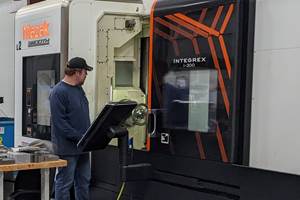Are U.S. Machine Shops Choosing to Stay Small for the Long Haul?
Spending plans offer a clue to the new way shops plan to expand their output.
Share





Earlier this year, I had the chance to speak to an audience in Europe about metalworking in the United States. The point I felt it most important to make to this group was also the simplest to express. Namely, in the United States, metalworking is done in facilities that are small. Small in staffing, that is. Metalworking is distinct from the rest of U.S. manufacturing in the extent to which this is true. With the findings of our latest Capital Spending Survey, we might be seeing what comes next for those small shops: They are choosing to stay small, or else accepting they must stay small, and they are setting out to realize a different sort of bigness.
Specifically, we have found that these shops plan to invest in capability—horizontal machining centers in particular—that will let them expand their machining output without adding staff. Steven Kline of (a division of the company that publishes this magazine) reports on this finding in his article, “The Shift to Horizontal Machining Centers Gathers Steam.”
Let me offer some data behind my point that metalworking is done in small shops. According to the U.S. Census Bureau, 83 percent of metalworking facilities have fewer than 20 employees. The proportion for manufacturing overall is 71 percent. That may seem like a slight difference, but when it comes to value added, the extent of the discrepancy expands. Shops smaller than 20 employees account for 26 percent of the metalworking value-added in the United States. These facilities account for 5 percent of value added in manufacturing broadly. Raise the scale to facilities with less than 50 employees, and this group makes up 53 percent of metalworking value-added versus 12 percent for manufacturing overall.
Perhaps most germane to this discussion is capital investment. Shops with fewer than 50 employees account for 60 percent of U.S. investment in metalworking technology. Small shops thus drive metalworking technology investment. The coming spending on HMCs is rising because small shops are shifting toward buying them. And their very smallness would seem to offer the most likely reason for the shift.
In the past, small shops would be expected to spend more of their limited resources on vertical machining centers, essentially getting more spindles per dollar. However, the one requirement of this approach is the need to increase skilled staffing at a rate in step with VMC purchases. Now, thanks to the difficulty many shops face in finding skilled personnel, combined with the rewards some have found in maintaining a small and highly focused staff, shops are either discouraged or disinclined to seek more employees. Instead, the investment is going instead into the kind of capital that can enable longer unattended operation, including increased use of the evening and weekend hours that likely have no staff at all.
In short, this simple fact about U.S. metalworking now seems coupled with a straightforward clue about what is to come. Namely, shops are finding the way to deliver high value despite their smallness, equipping and preparing themselves to achieve high productive capacity with few people. In the future, we might need to change our very definitions of what constitutes a shop that is small.
Related Content
Shop Tour Video: Inside a Family-Owned Machine Shop Specializing in High-Precision Plastics
In this episode of “View From My Shop,” East Coast Precision Manufacturing guides us through their plastics job shop. Learn how this shop has quickly and inexpensively built out its shop floor, as well as how it formed a niche for itself during difficult business conditions.
Read MoreIn Moldmaking, Mantle Process Addresses Lead Time and Talent Pool
A new process delivered through what looks like a standard machining center promises to streamline machining of injection mold cores and cavities and even answer the declining availability of toolmakers.
Read More5 Tips for Running a Profitable Aerospace Shop
Aerospace machining is a demanding and competitive sector of manufacturing, but this shop demonstrates five ways to find aerospace success.
Read MoreDN Solutions America Unveils Impressive Chicago Technical Center at IMTS 2024
New tech center is serving as a cutting-edge showroom and a technological hub for advanced machining applications.
Read MoreRead Next
Machine Shop MBA
Making Chips and 91ÊÓƵÍøÕ¾ÎÛ are teaming up for a new podcast series called Machine Shop MBA—designed to help manufacturers measure their success against the industry’s best. Through the lens of the Top Shops benchmarking program, the series explores the KPIs that set high-performing shops apart, from machine utilization and first-pass yield to employee engagement and revenue per employee.
Read MoreLast Chance! 2025 Top Shops Benchmarking Survey Still Open Through April 30
Don’t miss out! 91ÊÓƵÍøÕ¾ÎÛ's Top Shops Benchmarking Survey is still open — but not for long. This is your last chance to a receive free, customized benchmarking report that includes actionable feedback across several shopfloor and business metrics.
Read MoreAMRs Are Moving Into Manufacturing: 4 Considerations for Implementation
AMRs can provide a flexible, easy-to-use automation platform so long as manufacturers choose a suitable task and prepare their facilities.
Read More



















